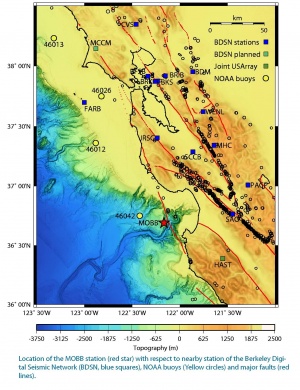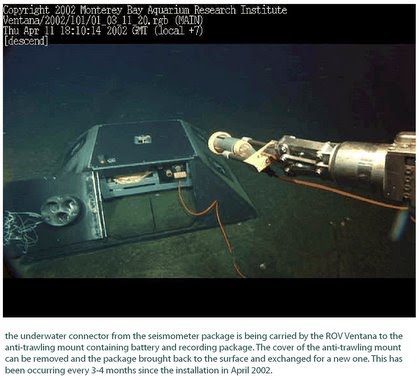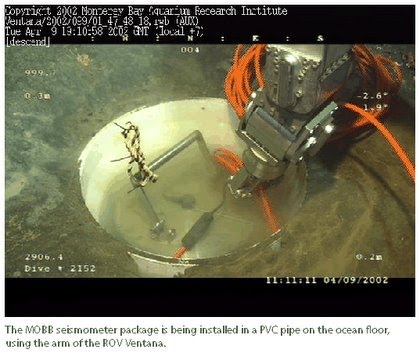Instrumenting the Ocean Floor
| |
For more information on the project, visit MOBB page at MBARI.
See related papers:
Romanowicz, B., D. Stakes, R. Uhrhammer, P. McGill, D. Neuhauser, T. Ramirez, D. Dolenc (2003) "The MOBB experiment: a prototype permanent off-shore ocean bottom broadband station," EOS Trans AGU, 84, 325-332.
Romanowicz, B., D. Stakes, D. Dolenc, D. Dolenc, P. McGill, R. Uhrhammer and T. Ramirez (2006) The Monterey Bay Broadband Ocean Bottom Seismic Observatory, Annals of Geophysics.
Publications related to MOBB data analysis
Two sources of background noises are particularly problematic in ocean bottom broadband seismic deployments:
1) long period noise in the infragravity wave band and
2) signal generated noise due to reverberations in the sediment column.
We explored these two issues in the following paper:
Dolenc, D., B. Romanowicz, R. Uhrhammer, P. McGill, D. Neuhauser and D. Stakes (2006) Identifying and Removing Noise from the Monterey Ocean Bottom Broadband Seismic Station (MOBB) data, G-cubed, 8, doi:10.1029/2006GC001403.
See also BSL Annual report for more detailed information
Documenting the origin of the infragravity wave noise and its relation to ocean storms and ocean waves as well as the earth's hum have been explored in the following papers:
Dolenc, D., B. Romanowicz, D. Stakes, P. McGill and D. Neuhauser (2005) Observations of infragravity waves at the Monterey Ocean Bottom broadband station (MOBB), Geochem, Geophys. Geosyst., 5, Q09002, doi:10.1029/2005GC000988.
See also BSL Annual report for more detailed information
Dolenc, D., B. Romanowicz, P. McGill and W. Wilcock (2008) Observations of Infragravity waves at the Ocean-Bottom Broadband seismic stations Endeavour (KEBB) and Explorer (KXBB), G-Cubed, 9, doi:10.1029/2008GC001942.
See also BSL Annual report BSL Annual report for more detailed information.
| |
This project follows a 3 months deployment in 1998 of a "half-buried" broadband seismic package in a similar location in Monterey Bay. This temporary deployment, MOISE (MOnterey Ocean bottom International Seismic Experiment) was a collaboration between MBARI, the Institut de Physique du Globe in Paris (IPGP), the Universite de Bretagne Occidentale (UBO), and the Berkeley Seismological Laboratory. The seismic package and recording system was installed with the help of the ROV Ventana, and featured the first underwater connections, performed from the ship Point Lobos, between the seismometer package, and recording and battery packages. The first time around, it took 3 hours for the Point Lobos operators to successfully achieve the connection. The experience gained led to a redesign of the topology of the interfaces, more practical for maneuvering with the ROV. For MOBB it now takes about 10 mn to disconnect and reconnect the seismometer package to the recording/battery system. The MOISE experiment also showed the importance of burying the seismometer package under the seafloor to reduce the influence of ocean bottom currents, leading to the MOBB design.
The MOISE deployment also included a 3 component electromagnetic package, which was deployed independently directly from the ship.
For more information about MOISE and the data produced, visit MOISE at MBARI
See related papers:
Stakes, D., B. Romanowicz, J.P. Montagner, P. Tarits, J-F. Karczewski, S. Etchemendy, D. Neuhauser,P. McGill, J.C. Koenig, J.Savary, M. Begnaud, M. Pasyanos (1998) "MOISE: Monterey Bay Ocean Bottom Intermational Seismic Experiment", EOS Trans AGU, 79, 301-309.
Romanowicz, B., D. Stakes, J.P. Montagner, P. Tarits, R. Uhrhammer, M. Begnaud, E. Stutzmann, M. Pasyanos, J-F. Karczewski, S. Etchemendy, D. Neuhauser (1998) "MOISE: A pilot experiment towards long term sea-floor observatories," Earth, Planets and Space, 50, 927-937.
Stutzmann, E. JP Montagner, et al. (2001) "MOISE: A prototype multiparameter Ocean-bottom station", Bull. Seism. Soc. Amer., 91, 885-892
Stakes, D. S., B. Romanowicz, M. Begnaud, K. McNally, J.P. Montagner, E. Stutzmann and M. Pasyanos (2002) "The MBARI Margin Seismology Experiment: A prototype seafloor observatory ", in "Science-Technology Synergy for Research in the Marine Environment: Challenges for the XXI Century, L. Beranzoli, P. Favali and G. Smirglio, Eds, Developments in Marine Technology, 12, 93-110.
Return to research highlights


